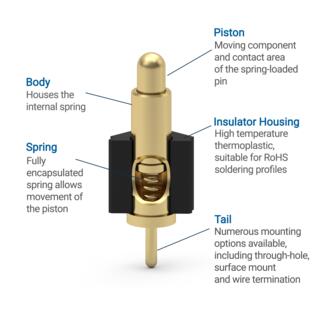Pogo Pins in Your Designs: How, Where, and When to Use Them
Pogo pin connectors are comprised of miniature spring-loaded pins, offering space-saving, fault-tolerant solutions for diverse applications. Their resilient spring mechanisms make an excellent choice for a connector due to the pogo pin’s reliable electrical contact.
From mobile device charging stations and electronics testing environments to wearable health monitors and automotive connections, pogo pins are becoming a popular connector choice. Growing from a $303.3 million global market in 2021 to a projected $623.12 million market by 2027, pogo pins’ demand in electronic devices and systems is steadily increasing.
To better understand the allure of pogo pins in electronic systems, we need to have a grasp of their construction, performance and common applications.
Understanding Pogo Pins
Structure and Function
A pogo pin is composed of four key components: piston, spring, body and cap. The piston (or plunger), along with the spring, are the moveable components of the spring-loaded pin. The tip of the piston makes connection with the mating surface while its flange contacts the inside of the spring-loaded pin body as it slides up and down. The part that gives the pogo pin its “pogo” action is the spring, pushing the piston outward to maintain constant pressure against the mating surface. The body (or barrel) of the pogo pin is the housing that holds everything together mechanically and electrically. The cap allows for different termination features, such as a solder tail, solder cup, or flat surface for SMT, for the same family of parts.
Materials
Common materials used in making Pogo pins are brass, beryllium copper, stainless steel and music wire. Brass offers excellent conductivity, machinability and affordability and can be used for all the components except the springs. Beryllium copper and stainless steel can be used for plungers, particularly in Pogo pins designed for use in testing applications. These hard, long wearing materials can stand up to the repeated probing of circuit boards. Music wire is an inexpensive spring material commonly used in lower cost Pogo pins; it is easy to form into springs but does not provide the longevity of beryllium copper or stainless steel. Beryllium copper and stainless steel are excellent material choices for springs due to their ability to maintain spring properties over the course of very high cycling, ability to withstand elevated temperatures and the manufacturing flexibility to meet a wide range of design requirements. Stainless steel is the optimal choice for high temperature applications while beryllium copper springs are best suited for use in high quality Pogo pins used in critical applications.
Gold Plating
Manufacturers gold plate Pogo pin connectors to optimize mechanical and electrical performance. Gold-plating on all the components offers superior conductivity, reduces contact resistance, helps to prevent corrosion and provides a durable surface for extended cycle life. For certain high reliability industries, e.g. connectors for military, aerospace and medical applications, a thicker gold plating may be specified on just the piston to meet minimum gold plating requirements at the contact point, or on all the components to protect against aggressive environmental conditions.
Advantages Over Other Connectors
It’s easy to understand why many devices are opting for pogo pin connectors. Pogo pins use blind mating and self-alignment, which makes connections foolproof. They are designed for durability and reliability, as their composition protects against vibration and shock. With a small form factor and the ability to offer high-density configurations, pogo pins enable elegant, intricate designs to fit their intended application. In addition, utilizing pogo pins can considerably reduce a device’s assembly process.
Applications and Considerations
As pogo pins become more prevalent in the electronics landscape, we find them providing robust connections in everyday devices. Many smartphones achieve flawless charging via pogo pin docking stations, while fitness trackers and smartwatches leverage their reliable performance for seamless data transfer and charging. The growing e-bike market is increasingly turning to pogo pins for user-friendly, reliable charging.
Beyond consumer devices, these versatile connectors can be found in medical equipment, offering uninterrupted signal integrity for life-critical patient monitoring and sensitive diagnostic tools. The automotive industry has also embraced pogo pins, using them to help illuminate interiors, assist with airbag deployment and provide secure battery connections.
You'll also find pogo pins being used in industrial and robotics fields. Their reliability and resilient spring mechanisms empower robots with precise movements and aid the efficient flow of industrial automation through connections in machine tools and assembly lines.
Pogo pins are especially useful in testing environments, where their incredibly high mating cycles (up to 1 million) stand up to the repeated connect-disconnect better than other options.
Mill-Max: The Pogo Pin Professionals
Mill-Max offers a catalog of hundreds of pogo pin connectors, all manufactured and assembled under the same roof in our Oyster Bay, New York facility. As leaders in the growing pogo pin arena, our innovative Omniball® Spring-Loaded Contacts are specifically designed for sliding and rotational connections. Whether you need an off-the-shelf or custom spring-loaded connector solution for your next project, the Mill-Max team is ready to get to work. Contact us today.


